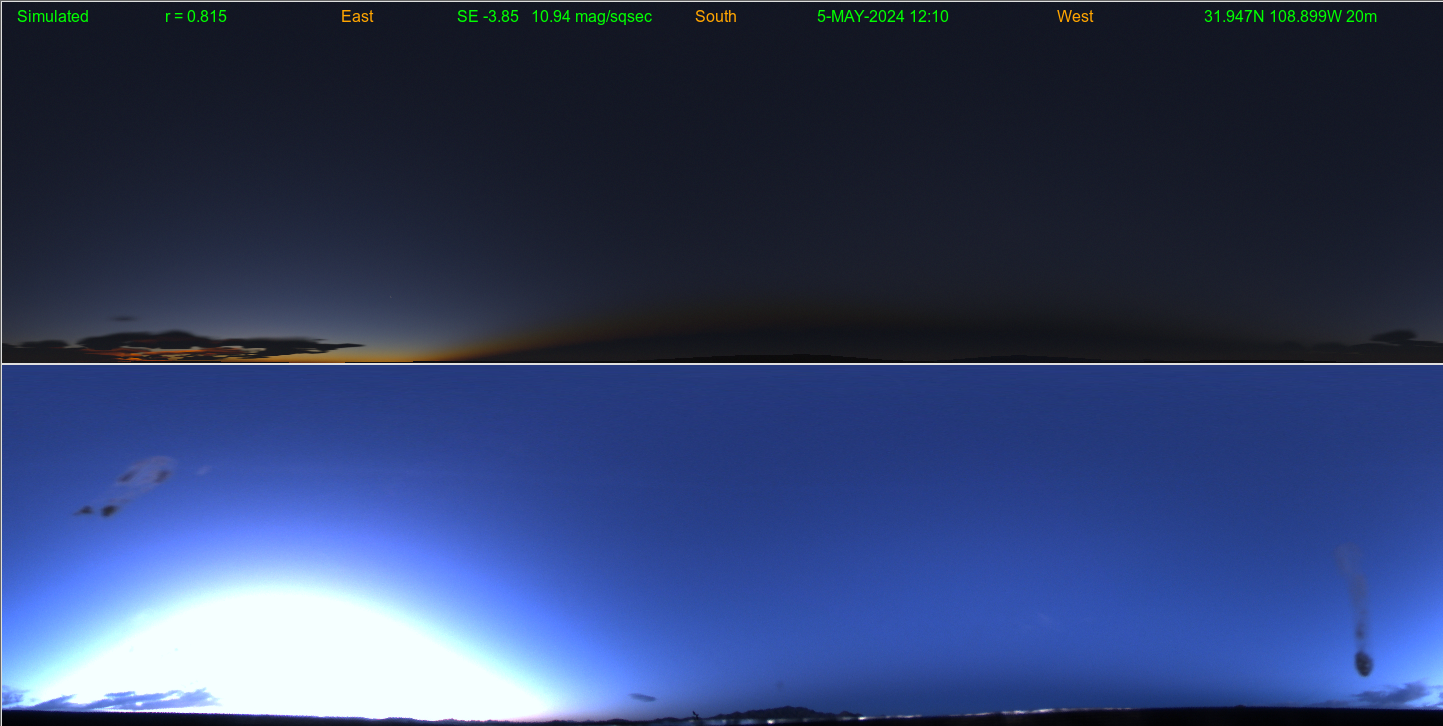Live Simulated Nighttime All-Sky Camera Images with Clouds and Aerosols |
Purpose
|
Gallery
|
Cases
Visually and physically realistic sky (and land) simulations are being produced from real-time gridded weather data,
obtained using a 3-D hydrometeor/aerosol analysis from an enhanced version of the
Local Analysis and Prediction System (E-LAPS), running over a
Colorado 500 meter resolution domain.
The analysis uses geostationary satellite (including IR and 500m resolution visible imagery, updated every 5 minutes), METARs, radar, aircraft, PM2.5, and model first
guess information to produce 3-D fields of cloud liquid, cloud ice, rain, snow, and aerosol extinction. Several land surface fields are also produced.
The 500m grid resolution takes advantage of the 500m satellite resolution in the visible wavelengths.
The gridded fields are converted using a ray-tracing technique into an all-sky image.
Details on the techniques behind these simulations can be found in this
journal article.
While the sun is the principal light source in the daytime, nighttime light sources from stars, zodiacal light, galactic glow, airglow and city lights are also included.
These visualizations have been made with analyses of present weather from E-LAPS along with forecasts from LAPS, WRF, FIM, CSU/RAMS, NAVGEM, and HRRR.
Preliminary camera assimilation work is being done using cloud mask algorithm output. Other variational assimilation (4DVAR), directly using visible and IR
radiance information (e.g. at a 1-minute cadence) from cameras and satellites in a tomographic fashion
is being proposed for use in various systems.
 The image above on the left is simulated from the E-LAPS cloud/aerosol analysis including satellite, camera, and other data,
while the independent image on the right is taken from the
Dark Sky New Mexico
amateur astronomy hosting facility with its
Alcor camera
at
the same time
.
In each
fisheye lens view
the zenith is in the center and north is up.
The color balance of the simulated image is set to reproduce the "actual" colors/radiances when the display white point is set to closely match the sun.
Thus to see a true apples to apples comparison (if for example you take your computer outside or right by a window), please set
your display to a color temperature of 5780K (the sun's white color above the atmosphere).
The image above on the left is simulated from the E-LAPS cloud/aerosol analysis including satellite, camera, and other data,
while the independent image on the right is taken from the
Dark Sky New Mexico
amateur astronomy hosting facility with its
Alcor camera
at
the same time
.
In each
fisheye lens view
the zenith is in the center and north is up.
The color balance of the simulated image is set to reproduce the "actual" colors/radiances when the display white point is set to closely match the sun.
Thus to see a true apples to apples comparison (if for example you take your computer outside or right by a window), please set
your display to a color temperature of 5780K (the sun's white color above the atmosphere).
Latest comparison animations
(site is LAS):
Polar
|
Cylindrical
 In these 360 degree panoramic (all-sky) views, a simulated cloud/aerosol analysis (using satellite though no camera) image is shown (top) compared with a remapped independent camera image (bottom)
from an all-sky camera located at NREL.
South is at the center of each image and north is at the edges.
In these 360 degree panoramic (all-sky) views, a simulated cloud/aerosol analysis (using satellite though no camera) image is shown (top) compared with a remapped independent camera image (bottom)
from an all-sky camera located at NREL.
South is at the center of each image and north is at the edges.
Archive Directories
(site is LAS):
Polar Comparison
|
Polar Blinking
|
Cylindrical Comparison
Other Related Endeavors
from around the web
More visualizations are on my main
home page
|
Contact:
Steve Albers
(Steven.Albers@colostate.edu)
 The image above on the left is simulated from the E-LAPS cloud/aerosol analysis including satellite, camera, and other data,
while the independent image on the right is taken from the
Dark Sky New Mexico
amateur astronomy hosting facility with its
Alcor camera
at
the same time
.
In each
fisheye lens view
the zenith is in the center and north is up.
The color balance of the simulated image is set to reproduce the "actual" colors/radiances when the display white point is set to closely match the sun.
Thus to see a true apples to apples comparison (if for example you take your computer outside or right by a window), please set
your display to a color temperature of 5780K (the sun's white color above the atmosphere).
The image above on the left is simulated from the E-LAPS cloud/aerosol analysis including satellite, camera, and other data,
while the independent image on the right is taken from the
Dark Sky New Mexico
amateur astronomy hosting facility with its
Alcor camera
at
the same time
.
In each
fisheye lens view
the zenith is in the center and north is up.
The color balance of the simulated image is set to reproduce the "actual" colors/radiances when the display white point is set to closely match the sun.
Thus to see a true apples to apples comparison (if for example you take your computer outside or right by a window), please set
your display to a color temperature of 5780K (the sun's white color above the atmosphere).
